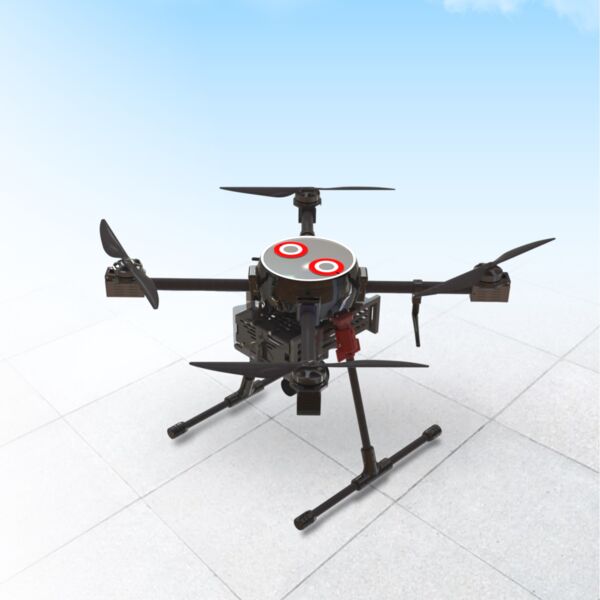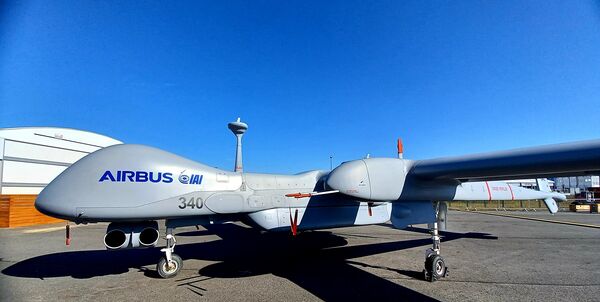- About
- Intara
- Capabilities
- Advisory
- Resources
- News
- Store
Indian MoD to procure 5G-enabled surveillance UAVs
29 February 2024
by Oishee Majumdar & Rakend P


The Indian MoD is procuring an undisclosed number of Jaga unmanned aerial vehicles (pictured) from Noida-based IG Drones to enhance the surveillance capabilities of the Indian Armed Forces. (IG Drones)
Noida-based IG Drones has secured a contract from the Indian Ministry of Defence (MoD) to provide its 5G-enabled Jaga unmanned aerial vehicles (UAVs) to enhance the surveillance capabilities of the Indian Armed Forces.
A spokesperson for IG Drones told Janes on 28 February that the company plans to complete the supply of an undisclosed number of its Jaga UAVs to the Indian MoD by the end of May.
The spokesperson said that Jaga is a vertical take-off and landing (VTOL) quadcopter that “can be deployed from any terrain without the need for a conventional runway”. The UAV has an endurance of five hours, a speed of 18–21 m/s, and an operating altitude of up to 400 ft above ground level, the spokesperson added.
Ariane 6 to launch second-gen Galileo satellites from 2026
02 May 2024
by Olivia Savage


The Ariane 6 launcher will launch the first batch of G2G satellites in 2026 and 2027. Pictured is a successful long-duration hot-fire test of the rocket on its launch pad at Europe's Spaceport in French Guiana in September 2023. The rocket is in its final stages of testing before its inaugural flight in June 2024. (Arianegroup)
The new Ariane 6 rocket will launch the initial batch of Galileo Second Generation (G2G) navigation satellites into orbit in 2026 and 2027, Arianespace announced on 29 April.
A total of four G2G satellites will be sent into orbit on Ariane 6 over two separate launches in 2026 and 2027. Airbus Defence and Space and Thales Alenia Space are each building six satellites, which together form the first fleet of G2G satellites, the company detailed.
The G2G satellites will use electric propulsion and host a more powerful navigation antenna as well as improved atomic clocks and fully digital payloads compared with the first-generation Galileo satellites. Each spacecraft will weigh 2,000 kg, orbiting at an altitude of 23,222 km (medium Earth orbit).
Luftwaffe declares Heron TP ready for Germany-based operations
02 May 2024
by Gareth Jennings


Seen at the ILA 2024 Berlin Air Show, the Heron TP has now been cleared for global operations by the Luftwaffe. (Janes/Gareth Jennings)
The Luftwaffe has declared its leased Israel Aerospace Industries (IAI) Heron TP unmanned aircraft systems (UASs) to be ready for Germany-based operations worldwide, with flights to commence in mid-May.
The Luftwaffe announced the milestone on 2 May, saying that the airworthiness certificate for the UAS had been signed by the German Federal Aviation Office in Cologne on the same day. “The approval of our new reconnaissance drone is valid worldwide,” the service said, adding that flights will soon commence out of Jagel (also known as Schleswig Air Base) in the far north of the country.
The announcement follows the Heron TP being awarded a type certificate by the German Military Aviation Authority in late 2022, at which time it was operated out of an undisclosed location in Israel.
The Heron TP is intended to bridge the gap between the retirement of the earlier Heron 1 UAS and the introduction of the new European medium-altitude long-endurance UAS known as Eurodrone, with Airbus Defence and Space operating five air vehicles out to 2027.
Modern Day Marine 2024: Kaman's Kargo enters flight-testing
01 May 2024
by Zach Rosenberg


The first Kaman Kargo in flight-testing at an undisclosed Pennsylvania site. (Kaman)
Kaman's Kargo medium-lift unmanned aerial vehicle (UAV) has been in flight-testing since December 2023, the company's general manager, Romin Dasmalchi, told Janes in advance of Modern Day Marine on 24 April.
The UAV first flew while tethered to the ground for safety reasons. The tether has since been removed, Dasmalchi said, and the first Kargo is free-flying at an undisclosed UAV testing site in Pennsylvania.
Following a flight, Dasmalchi said, “You would make an adjustment – call it a tuning adjustment – and then you fly it for a short period. You give it some inputs manually to see how it handles, then you land and you make adjustments. We probably did hundreds of those evolutions.” The Kargo might undergo 20 to 30 flights per day.
As of 26 April the first Kargo craft had accrued around 50 hours of flight time, Dasmalchi said, and hundreds of ignitions of its Rolls-Royce RR300 engine. Aside from changes to antenna placement, Dasmalchi anticipated no major changes to Kargos in production based on the results of flight-testing to date.
Noida-based IG Drones has secured a contract from the Indian Ministry of Defence (MoD) to provide it...
Latest Podcasts
Using OSINT to support law enforcement
Ritu Gill, Intelligence Analyst, joins Harry and Sean to discuss the practical use of OSINT to support law enforcement. Ritu discusses it’s use in supporting risk assessments and classified or closed sources of intelligence. She also discusses t...
Listen nowJanes Case Studies
Using Janes Intara to build a common intelligence picture: Russian build up on the Ukrainian border
View Case StudyNews Categories
 Sea Details
Sea Details